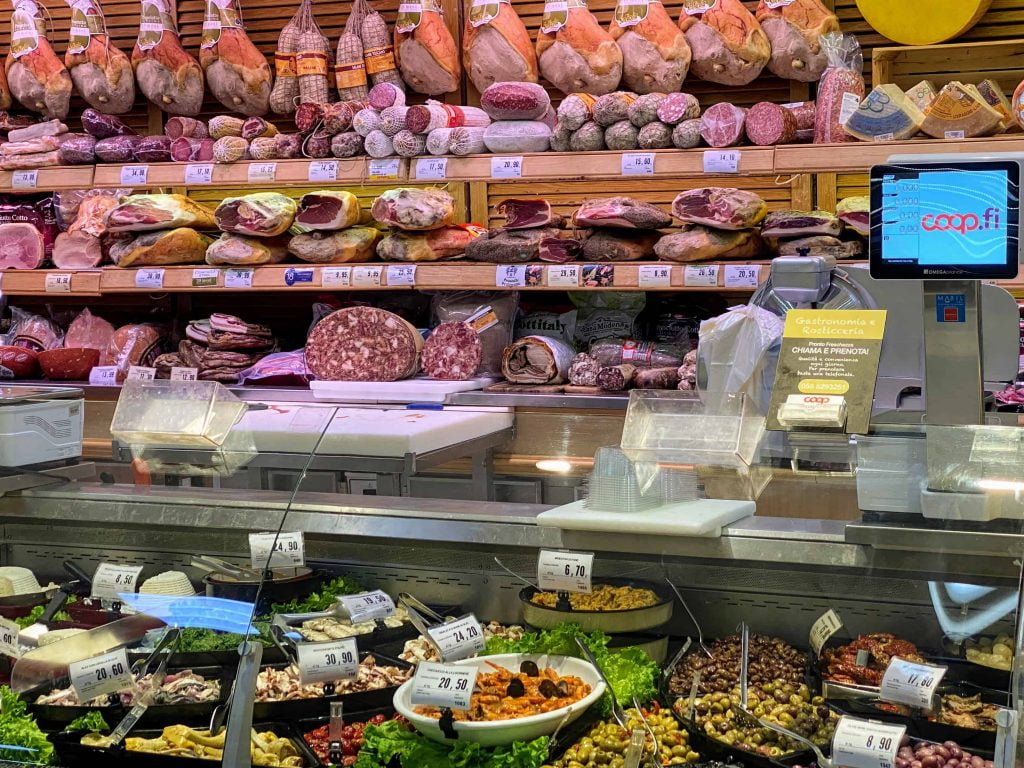Italian Supermarkets– different types of supermarkets in Italy, important things to know about shopping, helpful tips, useful words and phrases for shopping at an Italian supermarket and more!
Ah, grocery shopping in Italy. Is it really romantic like they show it in the films? Skipping along cobblestone streets, stopping in at the jolly bakery and choosing the freshest produce from the friendly neighborhood fruit seller?
Well, sure, some people here in Italy do still shop like that, but most of us with families and busy lives make our way to the supermarket, just like you do!
However, there are some differences between Italian supermarkets and those in your home country. Something as simple as buying food can be bewildering here in bella Italia.
Even if you don’t need anything at an Italian supermarket, if it’s your first visit to Italy, it’s a fun way for everyone – from toddlers to teens to adults – to soak up a little Italian culture. You can learn a lot about a place and its people by exploring its supermarkets.
So, let’s take a look at Italian supermarkets and some of their unique traits.
Table of Contents
Types of Supermarkets in Italy
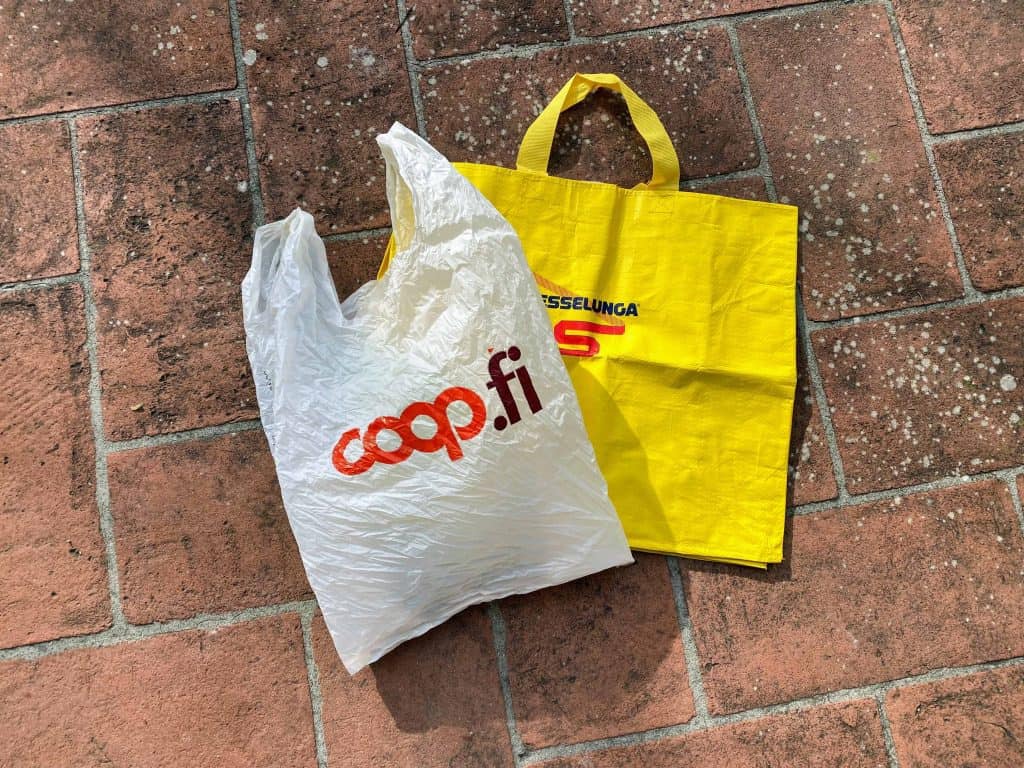
You may be wondering what supermarkets and grocery stores are called in Italy. The simple answer is: supermercato.
If you’re visiting Italy with your family and you need to pick up some fresh produce, snacks, picnic supplies, toiletries, or even diapers, you’ll want to ask someone where a supermarket is.
There are a few different types of grocery stores, and its helpful to know the differences between them. Italy has:
- ipermercati (hypermarkets)
- supermercati (supermarkets)
- convenience mercati (smaller supermarkets in city centers)
- alimentari (grocers)
- discount (discount chains)
- specialty shops
- mercati (open-air markets)
Ipermercati (Italian Hypermarkets)
These chains are similar to a Walmart or Target in that they have food and a whole lot more! Some of the popular hypermarkets you’ll see in Italy are:
- Auchan
- Bennet
- Carrefour
- Coop
- Conad
- Decò
- Despar
- Panorama
- Sisa
They’re so large that you won’t find them in city centers – they’re usually in a periphery zone. They always have large parking lots and are often accessible by bus.
If you’re visiting, it’s not worth going out of your way to visit one, but if you run across one, stop in to see the vast amount of Italian food and goods for sale. If you’re staying in one place for awhile and want to ‘settle in,’ this is where you’ll find the best prices on many food products, household goods, cleaning supplies, and baby products.
Supermercati (Italian Supermarkets)
You’ll find supermercati in busy cities, smaller towns, and in the countryside. It’s the ‘regular-size’ grocery store that carries an abundant selection of fresh food, non-perishable food, household essentials (kitchen supplies, cleaning supplies, and toiletries).
Good To Know: These regular grocery stores are much smaller than what you’re used to at home! The aisles are smaller and there aren’t 20 options for each product (except for the entire aisles of pasta, tomato sauce, and breakfast cookies). Whenever we head back to the US I’m amazed at how spacious Safeway and other US supermarkets are!
You may also find small sections with seasonal products (like candy for Valentine’s Day, coriandoli for Carnevale, Easter cakes, or panettone for Christmas) and clothing.
Some popular supermarkets you’ll see in Italy:
- Carrefour
- Conad
- Coop
- Crai
- Despar
- Esselunga
- Pam
- Sigma
- Sisa
We also have specialty supermarkets like Eataly, which carry typical Italian products, including some from the local area. They’re mostly in larger Italian cities but we even have one at an Autogrill, off the Autostrada!
Convenience Mercati (Smaller Supermarkets in Italian Town Centers)
The Italian word for these is actually the English ‘convenience.’ You may also hear them called ‘mini-markets.’
These ‘mini-size’ big chain grocery stores are popular in city centers. You’ll find the basics you’ll need as a tourist and locals can ‘get by’ with the food on offer, but there’s not a huge selection and the prices are usually a little higher than regular supermarkets or hypermarkets. Most locals will also head to a regular supermarket at some time during the week or month.
Often these minimarkets have ‘city’ in their names: Conad City, for example.
Alimentari (Grocers)
You’ll find alimentari throughout Italy, often family-run with a little Italian man behind the counter reading his newspaper. There may be an eclectic selection, and you may find dust on some of the products. But, chances are, if you ask, they’ll have what you need!
These are often great places to gather goods for a picnic (cheese, bread, jams, olives, wine) because they get fresh products from local producers.
Discount (Discount Supermarkets)
Discount supermarkets have become incredibly popular in Italy. You’ll find discounted food, fresh and non-perishable, but there’s usually less selection.
Some have theme weeks when you’ll find foods from certain regions of Italy or Europe. Some also have theme weeks for holidays and celebrations, like Valentine’s Day, Carnevale, Festa della Donna, Easter, Halloween, Thanksgiving, Christmas, and New Year’s.
The biggest discount chains in Italy are:
- Eurospin
- MD
- Lidl
- Tuodì
- Penny Market
- In’s Mercato
- DPiù
Specialty Shops
These are the beating heart of the Italian food scene. If you’re visiting, make a point of checking out the specialty shops for the cream of the crop – the best bread, fruits and vegetables, meats, and cheeses are all for sale in these specialty shops.
Head to the individual shops to get ingredients for a picnic or supplies for cooking a meal in your apartment.
- forno (bakery)
- fruttivendolo (fruit & vegetable shop)
- macelleria (butcher)
- pasticceria (pastry shop)
- pescheria (fish shop)
Mercati (Open-Air Food Markets)
Another way to find the freshest, in-season food – head to the village or city open-air market. Some are held daily, and others are once-a-week.
Vendors set up stands, tents, or sell out of their food trucks.
You can sometimes sample the products.
Observe which stands the locals head to – they know where the best prices and best cibo (food) is!
In this article, I’ll be focusing on the classic Italian supermercato (supermarket).
Main Sections of an Italian Supermarket
In an Italian grocery store, you’ll typically find the following areas:
Fresh Produce – fresh, in-season fruits and vegetables
Bakery – freshly baked bread and pastries
Deli – cheeses, cured meats
Refrigerated Section – milk, yogurt, packaged cheeses and meats, fresh pasta
Breakfast – packaged Italian breakfast cookies and pastries, cereal, granola bars, baking ingredients
Snacks – packaged bread and crackers, chips, nuts, juice, merendine (sweet and savory packaged snacks)
Fish – fresh fish
Meat – packaged or from the butcher: pollo (chicken), manzo (beef), vitello (veal), tacchino (turkey) and maiale (pork). You’ll also found ground meats (macinato), typically beef and pork, and sometimes turkey.
Senza Glutine – gluten-free pasta, packaged bread, crackers, cookies. Schar is the main company for gluten-free products in Italy, but many major Italian supermarket chains now make their own gluten-free products
Organic – ‘health food’ section with oats, non-wheat flours, healthy snacks, non-dairy milks, and more. Common non-dairy milks include avena (oat), cocco (coconut), riso (rice), soia (soy), and mandorla (almond).
Beverages – large selection of still (naturale) and sparkling (frizzante) water, soda (usually Coca Cola, Coke Zero, Fanta, Sprite, San Pellegrino and a few others)
Basics – pasta, tomato products, canned and Tetra-pak goods (scattole)
Toiletries – typical toiletries like shampoo, conditioner, soap, toothbrushes and toothpaste, and first-aid items, deoderant, feminine supplies (tampons, pads, panty liners)
Household items – toilet paper, paper towels, etc
Baby products – baby food, diapers, diaper cream, baby wipes, formula
Frozen – vegetables, meals, desserts, and other frozen foods (surgelati)
Alcohol – wine, beer, cocktail ingredients
Pharmacy – many Italian grocery stores now have mini pharmacies where you can buy over-the-counter products – a wide range of products like contact lense solution, high-end face creams, pregnancy tests, and after-bite (mosquito) ointments
Important Things to Know About Italian Supermarkets
You Need To Pay To Use A Cart
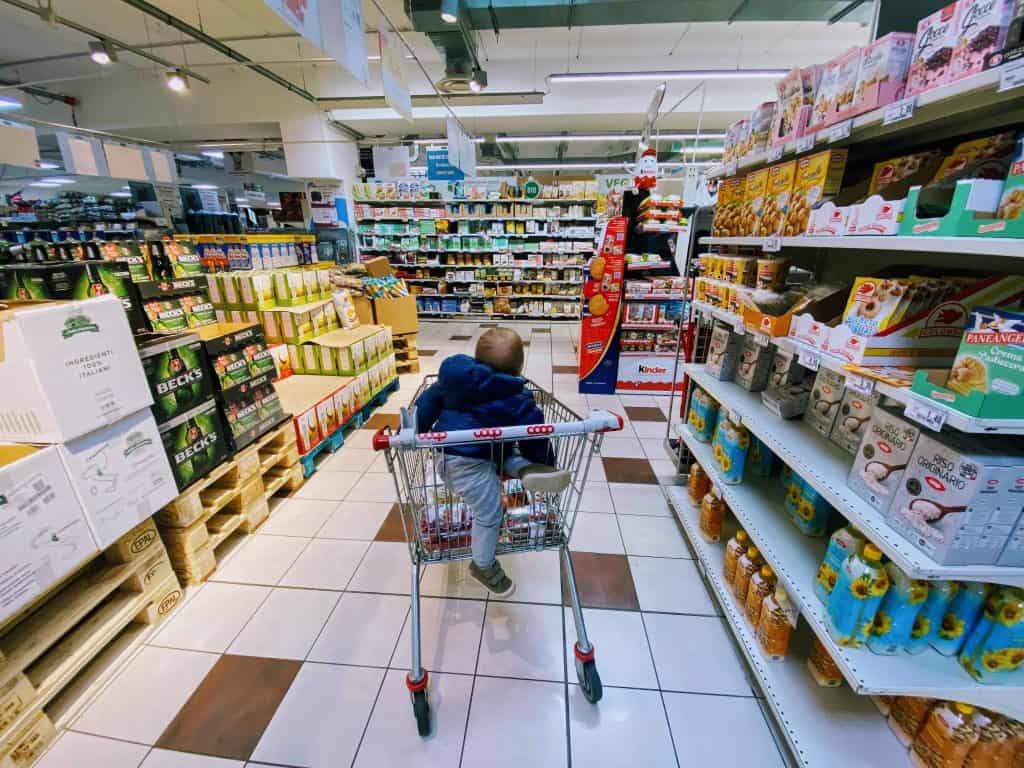
Put a coin in (usually €0.50 or €1 but will be written on the cart) to release the chain. When you’re finished shopping, return the cart where you got it, put the chain back in, and release your coin.
Why do we do this in Italy? It may seem silly, but at least we don’t end up with carts all over the lot and town. Everyone wants his coin back, so carts get returned!
If you don’t need a cart, you can use a small (often rolling) hand basket for free. They’re usually stacked at the store entrance.

Use a Glove To Handle Produce

Before you start gathering your fresh fruit and vegetables, you’ll need to put on a plastic glove. Yes, that’s right! Hygiene scorecard: Italy 1 – Everywhere Else 0.
There’s a dispenser (or a few) with the plastic bags in the produce area.
Good To Know: The plastic bags and gloves are biodegradable in many of the larger Italian grocery stores.
Once you’re gloved, feel free to touch and examine the produce. But don’t just throw it in your cart! You need to weigh your fruits and vegetables at Italian grocery stores.
Weigh Your Produce

Once you’ve chosen your produce, put it in a bag and note the number of the product on the sign nearby.
Then, take your bagged fruits or vegetables to one of the scales (a bilancia) in the area. Put the produce on the scale and enter the product number (sometimes there are pictures of the products).
Take the little sticker that comes out and stick it to the bag – all done!
Good To Know: You can skip the bag if you’d prefer not to use one. Just put the sticker directly on the produce.
Don’t forget to weigh your produce – the cashier doesn’t have a scale. If you forget, you’ll need to leave the line (with everyone waiting behind you!) to go weigh it.
Good To Know: There are exceptions to weighing fresh produce. You don’t need to weigh it if it already has a barcode on it (for example, the lettuce on the left in the photo above).
Order Fresh Meats and Cheeses From The Deli
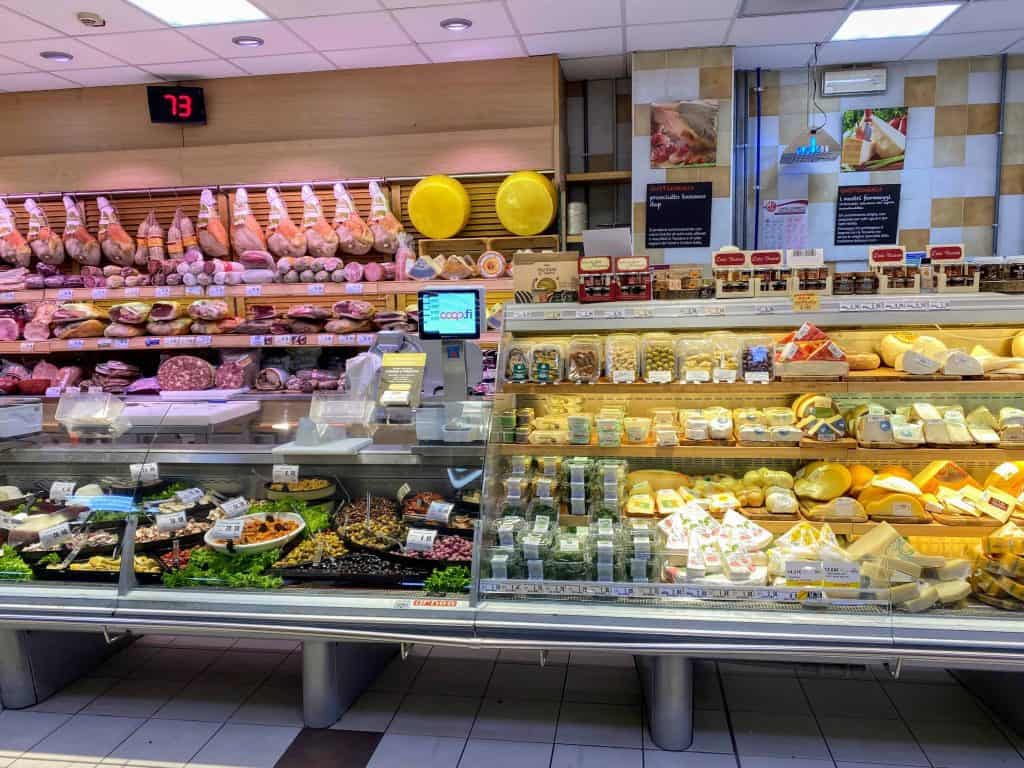
You’ll see packaged cheeses and meats in the refrigerated section. They’re fine to eat, but the best-tasting cheeses and meats are in the grocery store deli.
You usually need to get a number from the machine and wait to be called (or have your number show up on the digital display).
Good To Know: We order our meats and cheeses by the etto, or 1/10 of a kilogram (100 g). If you need to order more, you order etti.
For example:
Vorrei… (I would like…)
| Italian Weight Measurement | English Translation | Weight in pounds (lbs) |
|---|---|---|
| un etto | 100 grams | .22 lbs |
| due etti | 200 grams | .44 lbs |
| tre etti | 300 grams | .66 lbs |
| quattro etti | 400 grams | .88 lbs |
| mezzo kilo | ½ kilogram | 1.1 lbs |
| sei etti | 600 grams | 1.33 lbs |
| sette etti | 700 grams | 1.54 lbs |
| otto etti | 800 grams | 1.77 lbs |
| nove etti | 900 grams | 1.98 lbs |
| un kilo | 1 kilogram | 2.2 lbs |
Listen to the pronunciation here:
Good To Know: Ordering deli meat to make your own sandwiches? A good estimate is about 90 grams per sandwich, and I usually round up. So, if you want to make 3 sandwiches: 3 x 90 grams = 270 grams, and round up to 300 grams, or tre etti.
You can also ask the person serving you ‘per tre persone’ (three sandwiches) and he or she will slice a typical amount for three servings.
You can also say ‘va bene così, grazie’ or ‘basta così, grazie’ when you’re satisfied with the amount sliced.
Bring Your Own Bags Or Pay For Them
If you need to purchase bags, they’re usually €0.05-0.10 each, and are often the flimsy biodegradable bags. At larger stores you can purchase collapsible cardboard boxes, insulated bags (for cold food), and reusable bags.
The cashier may ask if you want bags, or you may see them where you put your groceries on the scanner belt. If you grab some there, put them on the scanner belt so the cashier can ring them up.
If you can, bring your own bags. It will save you some cash and will help our planet!
Bag Your Own Groceries
When it’s your turn to check out, place all of your groceries on the belt (or near the cashier if there’s no belt), then walk past the cashier to begin bagging your groceries as she rings them up.
Keep Things Moving: When the cashier has finished ringing up your groceries, stop bagging and pay. When you’re finished paying, you can continue bagging and the cashier can begin ringing up the next customer. There is usually a small divider in the bagging area and he/she’ll send the next customer’s groceries to the other side of the bagging area.
Use Your Receipt To Exit The Self-Checkout Area
If you choose the self-checkout area, don’t tuck your receipt away when you’re finished. You’ll need to scan your receipt to leave the area. Put the barcode of the receipt under the scanner and the gate will open up.
Good To Know: The self-checkout attendant may also ask to see your receipt to re-scan your items. It’s a random check and after the quick re-scan, you’ll be on your way.
Other Helpful Things To Know
Eggs Are Not Always Refrigerated
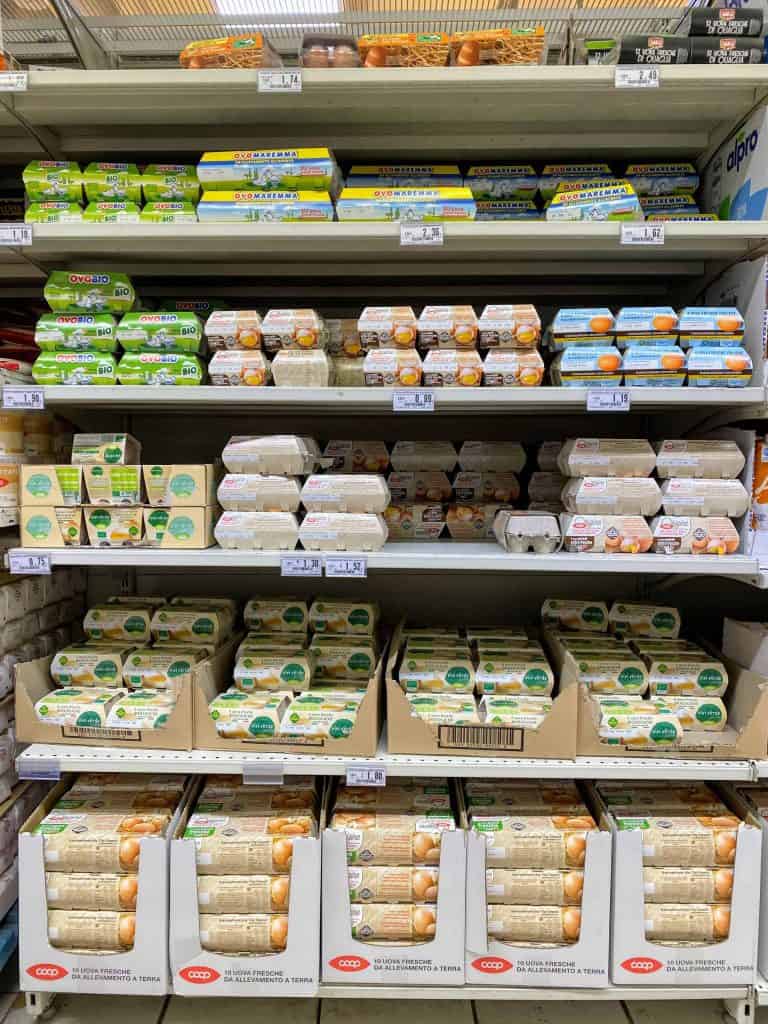
Not All Milk Is Refrigerated
Italy has fresh milk, as well as UHT (ultra high temperature) pasteurized milk, which is shelf-stable.
If you buy fresh milk in the refrigerated section, pay attention to the expiration date – it’s much sooner than you’re probably used to seeing in your home country.
Tell The Cashier How You’re Paying
If you’re paying with a credit card, tell the cashier, and he/she will tell you when to insert your card or tap it to the machine.
Good To Know: While large grocery stores in Italy will accept credit cards, smaller stores often do not (even though they’re legally required to), so it’s a good idea to always have some cash on hand.
Grocery Scanners Are Only For Store Loyalty Club Members

You may see small hand scanners on display at the store entrance. You can use them to scan your groceries and then scan the device at self-checkout to pay without having to remove your groceries from the cart.
If you want to use one, you need to be a store member and have a tessera (loyalty card). To free a hand scanner from the display, you scan your tessera.
Italian Grocery Stores Carry Toiletries
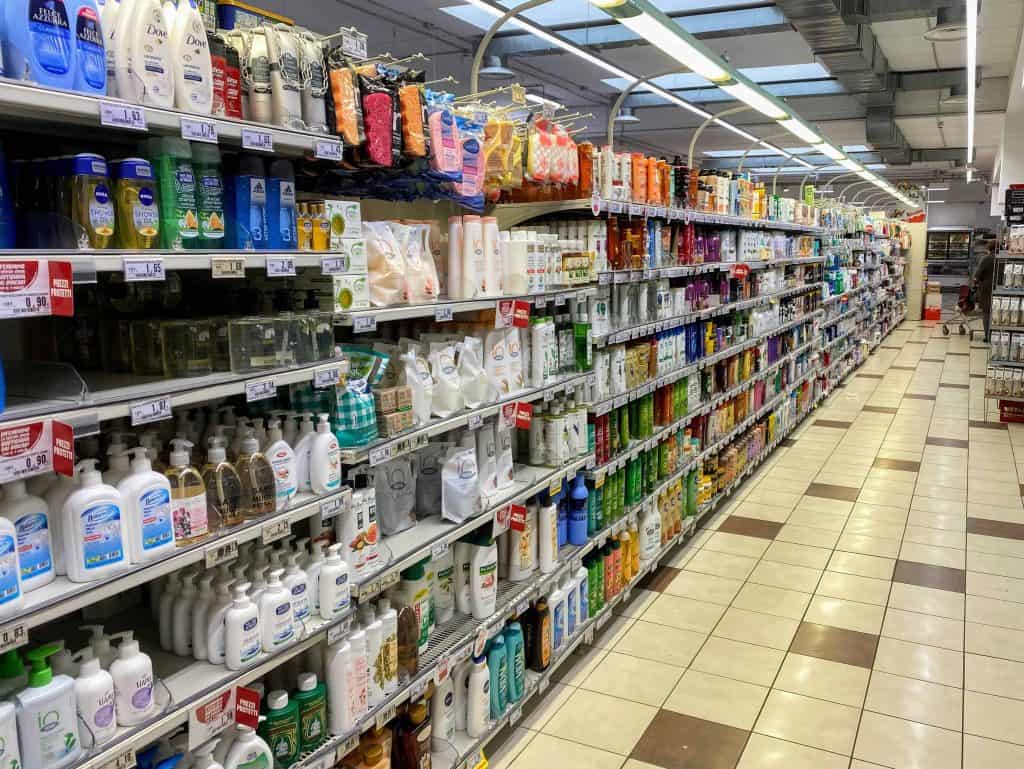
Grocery stores are some of the best places to buy shampoo, toothpaste, deodorant, baby products (diapers, diaper cream, baby wipes) and other essentials. In some towns, it may be your only option. In larger towns, it may be your cheapest option.
Toiletry stores like Caddy are popping up throughout the country, and there are perfume shops as well, but many (including our family) buy toiletries at the grocery store. We don’t have any stores with great prices like Target or Boots – yet.
Foreign Products Are Expensive
You may be missing favorite food products like peanut butter or tahini. Don’t be surprised by high prices for these often-imported goods. Try to eat local, seasonal foods if you can!
Also, these products may only be available during tourist season.
Italian Supermarkets Aren’t Open 24 Hours a Day
Italian supermarkets are generally open throughout the day, from morning until early evening. Hours vary depending on the chain and where it’s located. Grocery stores in cities are typically open early and close later than those in the countryside or smaller villages, which may also close for a lunch break (typically 1:00 pm – 4:00 pm).
It’s a good idea to check the hours by calling the supermarket (or have your hotel reception call for you). Google Maps will give you a good idea of the hours but closing days aren’t always updated, so don’t rely on the information.
Grocery stores in Italy may or may not be open on Sunday. It used to be rare to find supermarkets open on Sunday in Italy, but more and more are staying open, at least until lunchtime. Don’t rely on finding one open – always get what you need by Saturday evening.
Good To Know: The Autogrill (a restaurant/cafè/minimarket on Italian toll roads) is always open, so if you really need something, you can drive to the Autostrada and shop at the Autogrill. It’s more expensive, but you can get what you need.
Italian Grocery Stores Can Get Very Crowded
Italian grocery stores (except for the large hypermarkets) are often in compact spaces with narrow aisles.
If you can, try to shop at quieter times of the day – your shopping experience will be much more pleasant if you don’t have to fight your way through hordes of people or elbow nonne (Italian grannies) in the long lines at the cashier (just kidding – please don’t elbow any nonne).
Useful Words & Phrases For Italian Grocery Stores
Greetings & Basic Phrases
| buongiorno/buonasera | good morning / good afternoon or evening |
| arrivederci | goodbye |
| per favore | please |
| grazie | thank you |
| si | yes |
| no | no |
Listen to them here:
Navigating The Italian Grocery Store
| Dov’e’…? | Where Is…? |
| Scusi | Excuse me (to get someone’s attention) |
| Quanto costa? | How much does it cost? |
| sconto | discount |
| pesare | to weigh |
| Vorrei… | I would like… |
Listen to them here:
At Checkout
| busta/sacchetto | bag |
| carta di credito | credit card |
| contanti | cash |
| tessera | loyalty card |
| spiccioli | coins |
| banconote | banknotes |
Listen to them here:
Numbers
| Number | Italian | Pronunciation |
|---|---|---|
| 0 | zero | TSEH-roh |
| 1 | uno | OO-noh |
| 2 | due | DOO-eh |
| 3 | tre | treh |
| 4 | quattro | KWAH-troh |
| 5 | cinque | CHEEN-kweh |
| 6 | sei | say |
| 7 | sette | SEHT-teh |
| 8 | otto | OH-toh |
| 9 | nove | NO-veh |
| 10 | dieci | dee-EH-chee |
Listen to them here:
Staples To Buy At Italian Grocery Stores

Olio d’oliva (olive oil) – Best purchased after the harvest in November. Italian grocery stores have great olive oil – you don’t need to buy expensive oil or oil from a specialty shop.
Aceto Balsamico (balsamic vinegar)
Pasta – You’ll find an entire aisle of it at an Italian supermarket! In addition to the dried pasta aisle, there is fresh egg pasta in the refrigerated section. Tired of pasta? You’ll also find riso (rice).
Pane (bread) – Most Italian grocery stores have their own forno. We buy schiacciata and bread at the grocery store and in town at our bakery. Other bread staples like fette biscottate can be found in the packaged food section.
Aglio (garlic)
Pomodori (tomatoes) – Fresh and preserved tomatoes are staples in any Italian kitchen.
Erbe (herbs) – Basilico (basil), rosmarino (rosemary), timo (thyme), origano (oregano), prezzemolo (parsley) and alloro (bay leaves) are used often in Italian recipes.
Sott’olio (literally ‘under oil’) – These items, like sundried tomatoes, roasted eggplants, and olives, can be found preserved in oil in jars or in the deli. They’re great options for aperitivo!
Sott’aceto (literally ‘under vinegar’) – Capers, onions, and pickles are a few types of sott’aceti that you’ll find in jars or in the deli.
Salumi (cured pork) – Prosciutto cotto, prosciutto crudo, and salame, to name a few. Buy them packaged if you’re in a hurry; otherwise, take a number and wait for your turn to order freshly-sliced meats.
Formaggio (cheese) – Take your choice of Italy’s fresh and aged cheeses in the deli section or pre-packed in the refrigerated section. Grab classics like parmigiano, gorgonzola, or pecorino. Or, try a lesser-known local slice.
Frutta (fruit) – Most Italian supermarkets follow the seasons, so you’ll find fresh, in-season produce. Look for fragole (strawberries), pere (pears), albicocche (apricots), mele (apples), uva (grapes), pesche (peaches), arance (oranges), pompelmo (grapefruit). You’ll also find non-local produce like ananas (pineapple), mango, avocado.
Verdure (vegetables) – As with fruit, you’ll find fresh, in-season veggies in Italian grocery stores, including zucchine (zucchini), lattuga (lettuce), cetrioli (cucumbers), asparagi (asparagus), peperoni (bell peppers), carote (carrots), melanzane (eggplants, aubergines), cipolle (onions), patate (potatoes).
Supermarkets in Italy FAQ
Can I pay with Apple Pay in Italy?
In most cities, Apple Pay is widely accepted, but it’s still not used much in smaller towns and in the countryside. Make sure you have a backup method of payment with you.
Does Italy have a store like Costco?
Unfortunately, no. At one point Costco was looking into opening a store in Italy but the project was abandoned. While there was no official statement, I’m guessing it was a combination of (1) Italian bureaucracy, (2) the cost of doing business in Italy, and (3) the fact that Italians do not buy in bulk (lack of space in homes and avoidance of one-time large costs). We have some bulk warehouses, but they cater more to restaurants.
Do they have grocery stores in Italy?
Yes! Although many imagine that we shop at individual food stores (the butcher, the bakery, the fruit stand, etc), most Italians make their way into the grocery store on a regular basis. True, the food may not be quite as high quality as at the individual vendors, but the prices and convenience make Italian grocery stores popular here.
Does Italy have grocery delivery?
Grocery Delivery boomed during the COVID pandemic and it’s still going strong.
Much like in other places, it’s not perfect. You sometimes get a substitute or the product you want isn’t available. And, not everything is offered for delivery. But, for basics it’s a great option.
If you know you want to get your groceries delivered, put your order in as soon as you can, because the delivery calendar can fill up quickly, especially in cities.
We’ve used grocery delivery a few times but I prefer to choose the produce myself and I like to have the large assortment offered in the store.
Where can I find a supermarket in Italy?
Supermarkets are found throughout the country – in cities, the countryside, and everywhere inbetween. If you’re visiting a supermarket in the countryside, you’ll be able to park in a parking lot. In cities, it’s easiest to arrive by foot or public transport (even though they sometimes have tiny parking lots).
If you need to find a supermarket, you need to know the word for it and how to pronounce it! Supermercato, the general term for a grocery store or supermarket in Italy is pronounced soo-pehr-mehr-KAH-toe.
You can ask your hotel concierge, taxi driver, or a stranger on the street, “Per favore, dov’è un supermercato?” or “C’è un supermercato in zona?” (“Can you please tell me where a supermarket is?” or “Is there a supermarket in the area?”)
What are the most popular supermarkets in Italy?
The most popular supermarkets in Italy, by number of stores are:
- Conad
- Crai
- Coop
- Sisa
- Despar
- Carrefour
- Sigma
- Eurospin
- MD
- Margherita
- A&O
- Lidl
- Tuodì
- Penny Market
- In’s Mercato
- DPiù
- Decò
- Sogegross
- Famila
- Unes
- Todis
- Prix Quality
- Esselunga
- Pam
- Rossetto
- Alì
- Aldi
